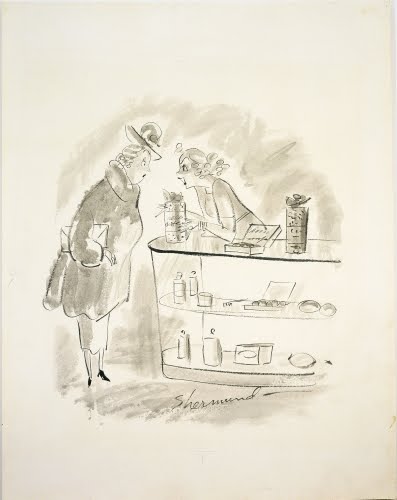Illustrator Barbara Shermund
As we know, women have been artists since the beginning of recorded time. The dawn of women artists as a significant part of magazine, book, and newspaper illustration, however, came at the end of the 1800s. Ironically, women artists were able to enter the world of illustration because all “proper young ladies” were trained in the art of sketching and watercolors from the Renaissance (1400–1600) on. Like “art pottery” and photography of the late 1800s, women were able to study illustration at home (“propriety”: no dirty art schools with their nude drawing classes!).
 |
| Barbara Shermund (1899–1978, US), Saleswoman: “This is a bath salt one may sit on.” Original drawing for a cartoon in The New Yorker magazine, 1938. Ink and wash on paper, sheet: 19" x 14 ¾" (48.3 x 37.5 cm). Image © 2018 Albright-Knox Art Gallery, Buffalo, NY. © 2018 Estate of Barbara Shermund/The New Yorker. (AK-4368) |
At the turn of the 1900s, the demand for illustration in printed matter was high, due in large part to the printing advances of the late 1800s that allowed for easier reproduction of illustrations—photolithography, chromolithography, and photography. In a field crowded with male artists, women illustrators had to be self-motivated and determined. Barbara Shermund (1899–1978) is an artist I just learned about, so I’m now letting you know about her.
Shermund was born in San Francisco to an artistic family: an architect father and sculptor mother. She started drawing as a child and studied at the California School of Arts, where she received an academic training in the basics. She subsequently moved to New York. Shermund started working for The New Yorker magazine four months after it was founded in February 1925. Almost at once (13 June, 1925), she had designed her first New Yorker cover, featuring a young woman with bobbed hair, very much in an Art Deco aesthetic.
Shermund’s cartoons mostly revolved around the so-called New Woman, a term that referred to women who had joined the work force beginning in the late 1800s. This term was particularly appropriate to address the state of women after World War I (1914–1918), when even more women were pushing the boundaries of what society deemed was “proper” for women. Shermund received inspiration for many of her gags from the social network in which she lived in New York. She depicted a broad range of women, from independent to traditional, set against the latest nuances of American society.
The artist was so driven by the subject matter for her cartoons that she reportedly slept with a pencil and pad under her pillow in case she came up with an idea in the middle of the night. She once admitted that she would work and rework a drawing twenty times so that it had the appearance of being spontaneous. She often worked only with a brush, employing dramatic, decorative washes to establish volume or depth. There is a description of her technique in the book by Liza Donnelly Funny Ladies: The New Yorker’s Greatest Women Cartoonists and Their Cartoons (Prometheus Books, 2005).
The astonishing career of women like Barbara Shermund (597 cartoons and eight covers) is in a stark contrast to many women illustrators of the late 1800s who often worked in virtual anonymity for male publishers. This was particularly true for the women who worked on the illustrations for Currier and Ives, with the exception of Flora Frances Palmer (1813–1876), who produced dozens of prints for that publisher. Shermund worked for The New Yorker until 1944 and was featured in a 1947 photograph by Irving Penn (1917–2009) of New Yorker illustrators. Shermund is the one in the broad-brimmed black hat.
Correlations to Davis programs: Explorations in Art 2E Grade 6: 3.1, 3.2


Comments